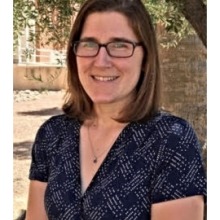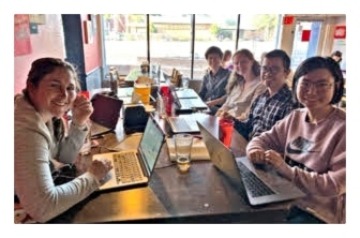The Knowledge of Water: Mapping and Sharing a Nation's Resource
A hydrology team harnesses software container technology for everything from developing virtual demos for student education to modeling groundwater resources across the United States.

Water is arguably one of the most essential resources known to humankind. And although invisible, groundwater – water beneath Earth's surface, in the cracks and spaces in soil, sand, and rock – is one of the United States' most valuable resources, used for irrigation, aquaculture, thermoelectricity, mining, and much more.
Laura Condon, an assistant professor of hydrology and atmospheric sciences at the University of Arizona, wants to understand that resource, collect that knowledge within a massive computational framework, and share it with others.
As part of the National Science Foundation cyberinfrastructure project Hydroframe,

Laura Condon
Condon is collaborating with researchers around the country to develop a hydrologic model of the entire nation's groundwater resources.
"Water is one of the most pressing issues for climate change," Condon said, "and we need big physical hydrology models in order to make predictions about how environmental changes will impact our water resources."
A major challenge with this research, she said, is that there are huge barriers to using these models because they're so computationally and data-intensive – it takes millions of core hours to run a model that then generates hundreds of terabytes of output – and they require so many skill-sets: you have to understand hydrology, computer science, software, and coding.
Many researchers don't have all these skills, Condon said, which means that the models often used to make resource planning decisions are not always the best models available for science.
The goal of Hydroframe is to make these high-level models accessible to researchers, educators, planners, and policymakers alike – without the need to know how to use high-performance computing applications.
To achieve this goal, she first had to teach her team how to use computing applications themselves.
Learning in order to teach
"My research is really at the interface of computer science and hydrology," she said, "but I was never trained as a computer scientist. It's just something that's not covered in our curriculum. And it's hard to pick up."
In 2019, Condon brought her lab team to CyVerse's Container Camp, an intensive, hands-on workshop that teaches researchers in any discipline the basics of working with container technology.
Containers are software applications that comprise all the computing code and dependencies – such as libraries and configuration files; the things that tell the software how to work – in one place so that the application runs quickly and reliably regardless of the computing environment.
CyVerse's Container Camp brings attendees from the basics of how to containerize applications and how to then use them, to how to connect their computations to cloud and high-performance computing (HPC) resources.
"Container Camp was really accessible to my students, to people who have a science background but not a computer science background," Condon said. "We have hydrology students working with software developers, and Container Camp lowered the linguistic barriers between these disciplines."

Condon's team of students and postdocs continued their work in the evenings while attending CyVerse's Container Camp in 2018.
Before attending Camp, Jun Zhang, a postdoctoral researcher in Condon's lab, had never worked with containers. With the knowledge she gained at Camp, she can now use them to share her modeling work with the hydrologic model ParFlow.
"ParFlow is a complicated hydrologic model and difficult to install in a short time," she said. "With ParFlow in a container, I can share the model easily with other researchers and access it anywhere with an internet connection, even when I don't have my own laptop with me."
At Container Camp, Condon's team was able to sketch out their specific project goals together, with the camp instructors available to advise them.
"After Container Camp, we have been able to set up our modeling platform so that when we make changes to the model, we automatically have containerized versions," Condon said. She added that in the future, the goal is to expand on this capability so that "anyone could come to Hydroframe and select the data and model for their area of interest such as a local watershed. We'll just hand them the container that has everything they need."
Condon also appreciated how the Container Camp curriculum demonstrated examples of how large projects, such as the Event Horizon Telescope, use containers, showcasing how to get from the very basics to the very big.
"I think it helped the students really engage," she said – and engaging students is one of her top priorities.
Visualizing the invisible
"It's hard to teach about groundwater," Condon commented, "because groundwater, being underground, is really hard to see."
Which is why Condon's team is working with software company Kitware to create computer visualizations of how water moves underground. The physical equivalent of the model is called a sand tank: a glass-walled chamber filled with different layers of dirt, rock, and gravel. Colored water is poured in somewhere on the surface, and observers can watch as the stained water travels through the layers.
"We wanted to connect that physical understanding to what you see in a computer model. With KitWare and Hydroframe collaborators at the Colorado School of Mines, we developed a web interface which uses containers to launch our model to look exactly like a sand tank," Condon explained. "Students can pull it up on individual computers and change the boundaries, and take measurements. All that's happening is in the background we have our model running in a container."
Additionally, Condon added, "one of the big barriers for students is building and compiling code. In our courses, we can just give them a container that works on everything."
From modeling a national resource to supporting student science, Condon and her collaborators have discovered how to use container technology to ease the path of scientific discovery for themselves and many others. "If we didn't have containers, then none of this would work," she said.
In their efforts to understand our nation's groundwater, Condon and her collaborators may have learned the most important knowledge of all: how to share our most precious resources, be they technology, knowledge – or water.
CyVerse's Container Camp lessons, tutorials, and documentation are freely available through CyVerse Learning.
Hydroframe partners include the National Science Foundation, the Colorado School of mines, the University of Arizona, Boise State University, the University of Colorado Boulder, the National Center for Atmospheric Research, the Consortium of Universities for the Advancement of Hydrologic Science, the San Diego Supercomputer Center, Utah State University, and Kitware.

